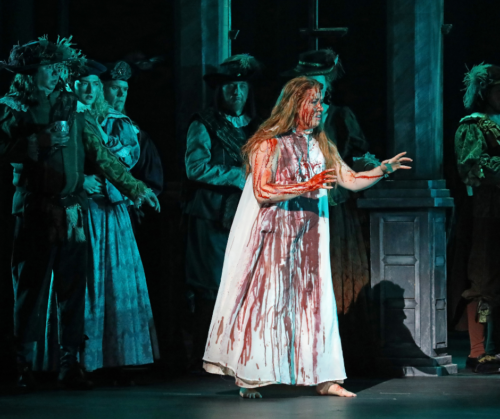From the Nashville Opera
The Bloody Tragedy Lucia di Lammermoor by Gaetano Donizetti
The bloody tragedy Lucia di Lammermoor by Gaetano Donizetti (1797-1848) originally premiered in 1835. It is a Romantic opera is loosely based on the novel by Sir Walter Scott, The Bride of Lammermoor, and is known for its lush music and the histrionics of the Mad Scene, one of opera’s most technically challenging soprano coloratura roles. The story follows two star-crossed lovers. On one side, we find a young girl, Lucia Ashton, and her failing aristocratic family, in financial crisis and feuding with another family, the Ravenswoods. The other star-crossed lover is Edgardo Ravenwood. Despite this, after a series of unfortunate events and deceptions, Lucia is manipulated into marrying a man she does not know, and is heartbroken. Chaos ensues.
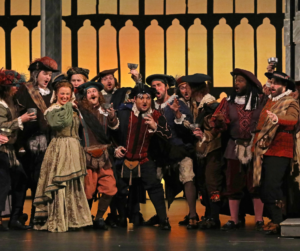
Set in the Scottish moorlands, the costumes, originally designed for the Utah Opera by Susan Allred, and the overall color scheme were comprised of rich green, crimson, blue, velvets, and plaid; they were immediate eye catchers. The colors and red hair of siblings Enrico and Lucia transported the audience back in time. The lighting, by designer Barry Steele, played a large role in creating the ambiance for each scene. From lighting up the stained-glass windows in the first scene, to using brilliant silhouettes portraying latticework windows, and, in Edgardo’s last scene, the outlines of the gates to his family’s tomb, as well as changing the backdrops colors to portray Lucia’s bi-polar moods, the lighting work in the production was well done.
The chorus was delightful. There was energy and banter at every corner of the stage. Their charisma and the sound as the chorus gasped and gawked as Lucia’s wedding night unfolded helped set the stage as much as the set design, which was splendid.
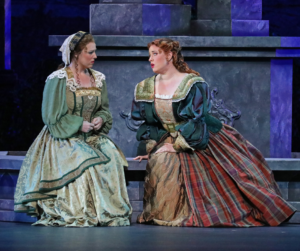
In addition, Dean Williamson, Nashville Opera’s music director, and the orchestra were the unseen heroes of the opera. The orchestra’s lush, romantic sound continuously filled the hall, and the harp in particular, played by Vonda Darr, was exquisite.
The first act opened with the aforementioned stained glass windows, a permanent feature of the opera provided by the New Orleans Opera Association, lit with blues and light reds during Act 1’s first few scenes. Rainelle Krause, playing Lucia, enters in the first act, second scene telling her friend, the maid Alisa, played by Sara Crigger, another talent, of her dreams sitting by a huge fountain, the stage’s centerpiece. Here, the audience is introduced to Rainelle’s crystalline voice and vocal acuity for the first time as she sings about her beloved Edgardo (César Delgado), who soon arrives to tell Lucia that he must leave for France. Edgardo asks Lucia to marry him, saying he will go to her brother Enrico to end the feud between their families so the two can be married. Lucia refuses, saying their love must stay a secret for now. The two exchange vows and rings before God, and Edgardo leaves.

In the next scene, the audience learns more about Enrico, played by Timothy Mix. His facial expressions were fantastic and as dramatic as his voice. Insanity must run in the family, because he seems about two steps away from it. His domineering and lascivious personality is shown in Act 1, Scene 3, as he manipulates Lucia into believing her beloved Edgardo has betrayed her.

For me, one of the highlights of Saturday night’s performance was the Sextet. “Chi mi Frena in tal Momento” is the fallout of Edgardo’s sudden return, discovering that Lucia is married, and Lucia simultaneously realizing she has been lied to by her brother and the Chaplain. During the sextet, Lucia, Edgardo, Enrico, Raimondo, Arturo, and Alisa all expressed their feelings about Lucia’s marriage. The sextet began with the whole cast, besides Edgardo and Enrico, frozen in place. The two sing, hands on the hilts of their swords, wanting to fight but unable to. Lucia was the next to enter, followed by Raimondo, Alisa, and finally Arturo. A spotlight landed on each cast member, casting a brighter light and differentiating the singers from the chorus, still frozen in place.
Following the sextet, Edgardo’s death scene was touching. The curtain still down, Edgardo walked across the front of the stage with nothing but the shadows of his family’s final resting place in the background. The effect was simple but effective, focusing the audience on Edgardo’s desolation at having been betrayed by his beloved Lucia, who is currently murdering her husband in the hope of being reunited with him. Delgado’s instrument was beautiful, with a direct, radiant tone. Donizetti’s melody fit so well with his voice that it seemed to be written for him. William Guanbo Su, playing the Chaplain Raimondo Bidebent, was the first to witness the horrors committed by the mentally unstable Lucia. He did a convincing job of heralding in Lucia’s coming Mad Scene. His rich voice and the shock written across his face in the aftermath of seeing Arturo dead, stabbed to death at his wife’s hand, was well done. Though he and Enrico were wrong for forcing Lucia to marry someone against her will, as I watched Bidebent cradle his head, praying, I couldn’t help but feel sorry for him.
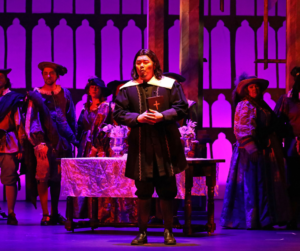
Attention doesn’t stay on the Chaplain for long as Lucia makes her entrance. She swept onto the grand marble staircase, and I was immediately drawn in. Starting with her back to the audience, her hand, covered in blood, moved with a sick grace as she brandished the same knife she used to kill her husband, Arturo. When she finally turned to face the audience, staggering her way down the stairs, her expression was angelic, quite a discrepancy from the blood covering her face. The front of her bridal gown was also stained red. The chorus, already buzzing with fear from Chaplain’s shocking revelation, was horrified by Lucia’s appearance. Their fear juxtaposed against Lucia’s madness created quite the scene. Lucia, having gone mad, at times seemed happy: ready to see her true love, Edgardo, again, only to suddenly become fearful, crying and pacing the stage, waving her dagger wildly at her wedding guests.
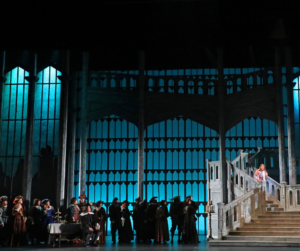
I cannot say enough about Rainelle’s constant, clear, healthy sound. The Mad Scene alone is over twenty minutes long, and her impressive coloratura and crystal-clear high notes were a dream. Her back and forth with the flute solo, performed by Deanna Little, was entrancing. In my interview with Krause, she stated that she believes Lucia can hear the flute and is singing in response, a sign of her madness. During the performance, it was apparent that Lucia could not only hear the flute but was also looking for it. Lucia’s rapidly changing emotions and fluctuating melody added to the sense of instability throughout the piece. The melismatic phrases seemed never-ending, and in the rare instances where the flute wasn’t imitating her, or vice versa, but playing and singing in unison, they sounded like one instrument. Finally, fantasizing that Edgardo is with her again, she promises to be with him forever in heaven. Lucia ends her own life, and the opera ends.
The story of Lucia is a sad, twisted tale. Perhaps Lucia and Edgardo do find each other in the afterlife, but the audience is only left with the tragic aftermath. Directed by John Hoomes, the cast, orchestra, costumes, and lighting director created an excellent production of Lucia di Lammermoor.
